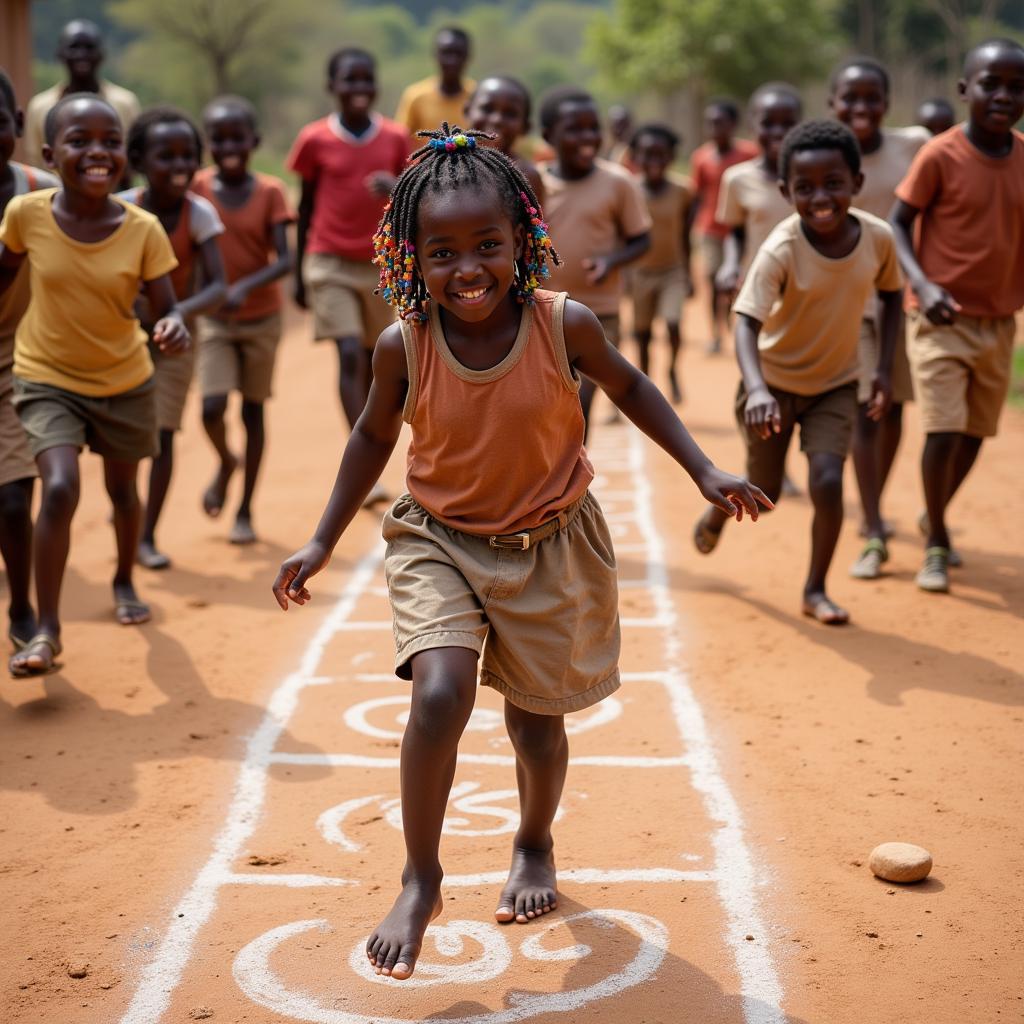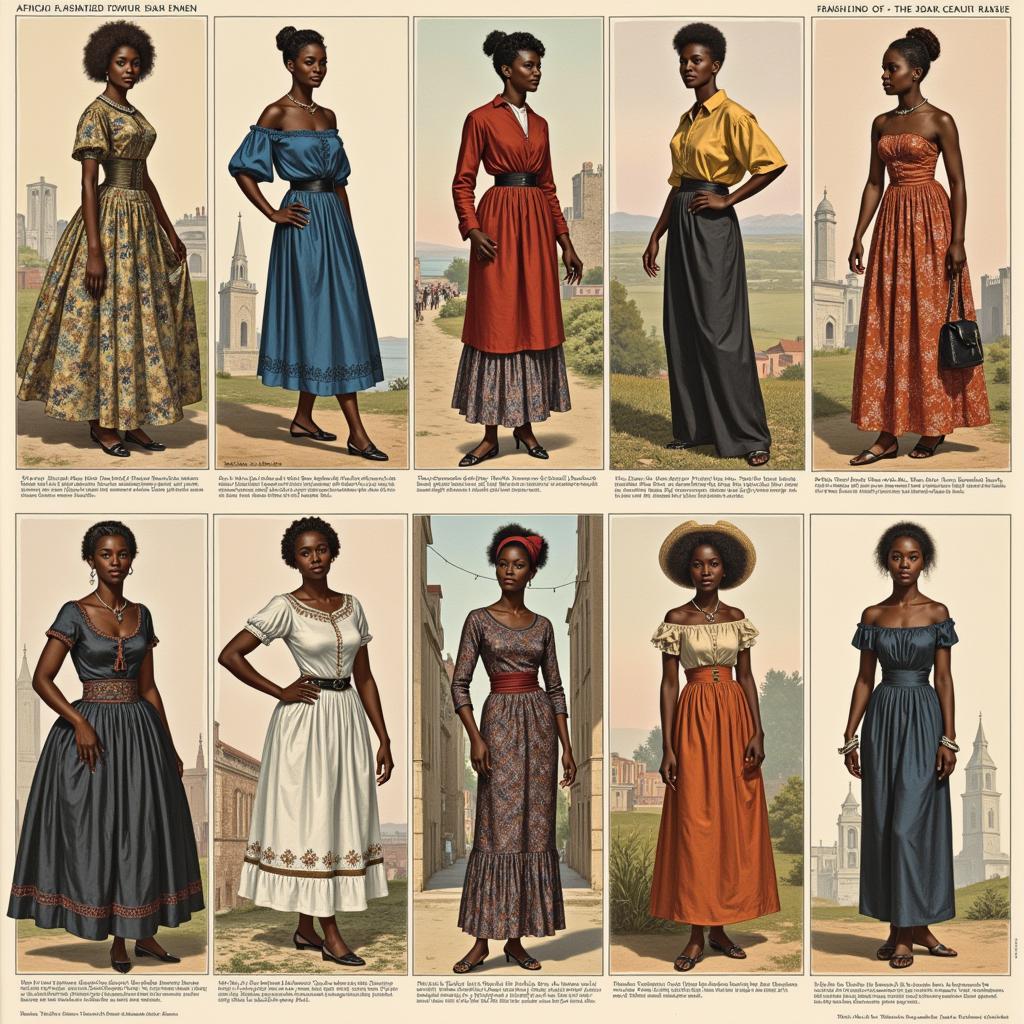Jumping Through Time: Exploring the World of African Hopscotch
African Hopscotch is more than just a children’s game. It’s a cultural tradition, a physical challenge, and a vibrant expression of creativity that has been passed down through generations across the African continent. While the basic concept of hopping across a pattern drawn on the ground remains constant, African hopscotch takes on countless variations, each reflecting the unique customs and artistic sensibilities of the community from which it originates.
 Children Playing Hopscotch in Africa
Children Playing Hopscotch in Africa
A Tapestry of Names and Patterns
One of the most fascinating aspects of African hopscotch is the sheer diversity of its names and designs. In many parts of East Africa, the game is known as “kikarla,” while in West Africa, you might hear it called “chanté,” “nelo,” or “tinko.” These names often reflect the linguistic tapestry of the continent, with influences from Arabic, French, and indigenous languages intertwining to create a rich cultural blend.
The patterns used in African hopscotch are just as varied. Some designs are simple, consisting of a linear sequence of squares, while others are incredibly intricate, resembling elaborate mandalas or geometric puzzles. These patterns often hold symbolic meaning, representing anything from animals and plants to ancestral spirits and cosmological beliefs.
 Intricate Hopscotch Patterns on the Ground
Intricate Hopscotch Patterns on the Ground
More Than Just a Game: The Social and Educational Significance
Beyond its entertainment value, African hopscotch plays a significant role in the social and educational development of children. The game promotes physical coordination, balance, and spatial awareness. As children navigate the complex patterns, they develop their motor skills and learn to strategize their movements.
Moreover, African hopscotch fosters social interaction and reinforces community bonds. Children often play together in groups, taking turns, cheering each other on, and learning to follow the rules of the game. This shared experience strengthens friendships and teaches valuable lessons about teamwork, fair play, and respect for others.
 African Children Playing Hopscotch Together
African Children Playing Hopscotch Together
Passing Down Traditions: Keeping the Legacy Alive
In many African communities, the tradition of hopscotch is passed down from older children to younger ones, ensuring the continuity of this cherished cultural practice. As children grow older, they, in turn, teach the game to the next generation, sharing not just the rules but also the stories, songs, and cultural meanings associated with each pattern.
“My grandmother taught me how to play hopscotch using the patterns her mother had taught her,” recalls Abena, a craftswoman from Ghana. “Each pattern had a story, a lesson about our history or our ancestors. It was a way of connecting with the past, of keeping our heritage alive.”
This intergenerational transmission of knowledge helps to preserve cultural heritage and ensures that the rich traditions associated with African hopscotch continue to thrive in the face of modernization and globalization.
Hopscotching into the Future: Adapting to a Changing World
While African hopscotch remains deeply rooted in tradition, it has also shown a remarkable ability to adapt to changing times. In some urban areas, where concrete playgrounds have replaced open spaces, children have found innovative ways to play their beloved game, using chalk to draw their patterns on sidewalks or adapting the rules to suit their surroundings.
Even as technology continues to reshape childhood experiences, the simple joy of hopping across a pattern drawn on the ground continues to resonate with children across Africa. African hopscotch, with its rich history, cultural significance, and enduring appeal, serves as a powerful reminder of the importance of play, tradition, and the enduring power of human connection.
FAQ: Jumping into the World of African Hopscotch
1. What are some other names for African hopscotch?
African hopscotch is known by many names across the continent, including “kikarla,” “chanté,” “nelo,” and “tinko,” among others.
2. What is the significance of the patterns used in African hopscotch?
The patterns often hold symbolic meaning, representing animals, plants, ancestral spirits, or cosmological beliefs. They reflect the cultural values and traditions of the community.
3. How does African hopscotch benefit children’s development?
The game promotes physical coordination, balance, spatial awareness, and social interaction. It also teaches valuable lessons about teamwork, fair play, and respect.
4. How is the tradition of African hopscotch passed down through generations?
Older children often teach the game to younger ones, sharing the rules, stories, and cultural meanings associated with each pattern.
5. Is African hopscotch still popular today?
Yes, despite the rise of technology, African hopscotch remains a popular pastime for children across the continent, adapting to new environments and ensuring its continued legacy.
Looking for More?
If you’re interested in learning more about the lives of children in Africa, you might enjoy these articles:
Or perhaps you’d be fascinated by the cultural richness of african american cultural games.
Remember the joy and laughter a simple phrase like “african kid oh my god” can evoke.
Let’s continue exploring the vibrant tapestry of African culture together!

